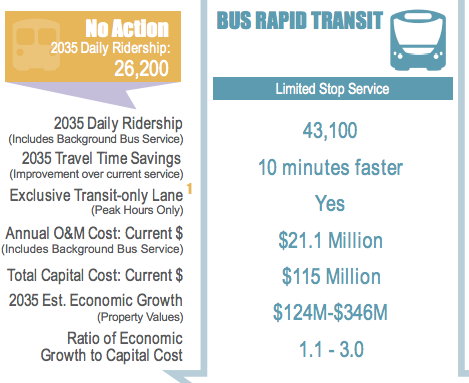Hancock Makes Room for Colfax BRT in 2016 Budget

Denver has studied bus rapid transit (BRT) on East Colfax Avenue for a long time, and now it looks like the city is ready to take concrete steps to make it happen. Mayor Michael Hancock’s budget sets aside $1.2 million to design the BRT route, which would connect downtown Denver with Aurora over a nine-mile span.
Colfax is Denver’s busiest bus corridor, with 22,000 riders every weekday, according to a corridor study. But the street itself doesn’t cater to buses, or the people riding them. Instead it’s one of the city’s most dangerous streets for pedestrians, and buses carrying dozens of people have to maneuver sluggishly around the single-occupancy vehicles Colfax was built for.
Colfax BRT would change that aggravating experience. Buses would have their own lane in each direction during morning and afternoon rush hour, making the ride quicker by 10 to 11 minutes, according to projections. Riders would only wait five minutes between bus arrivals, and smooth, quick, all-door boarding will replace the standard, clunky process. With “transit signal priority,” lights will stay green longer if a bus is approaching, keeping passengers moving. Distinct bus stations will replace bus stops, and the street is supposed to get safer for walking and biking — though the plan hasn’t given us any specifics.
All of these changes amount to a better rider experience, and will lead people to choose the bus instead of their car.
With BRT, Colfax will be able to accommodate the city’s growth without getting overrun by traffic. Over the next 20 years, the nine-mile stretch is projected to see a 25 percent increase in individual trips, 67 percent more jobs, and a 25 percent growth in population. Transit can move more people using less space than car lanes, but only if the city sets it up to be useful. Planners project that with BRT, by 2035 bus ridership on Colfax would double compared to today, and would be 65 percent higher than with no BRT.

Some people think a streetcar would do better on Colfax, but everything else being equal, buses work about just as well as streetcars, writes transit expert Jarrett Walker:
Streetcars that replace bus lines are not a mobility or access improvement. If you replace a bus with a streetcar on the same route, and make no other improvements, nobody will be able to get anywhere any faster than they could before. This makes streetcars quite different from most of the other transit investments being discussed today.
Where a streetcar is faster or more reliable than the bus route it replaced, this is because other improvements were made at the same time — improvements that could just as well have been made for the bus route. These improvements may have been politically packaged as part of the streetcar project, but they were logically independent, so their benefits are not really benefits of the streetcar as compared to the bus.
A streetcar on Colfax would serve about the same amount of people at about the same speed as BRT, but would cost much more, according to the Colfax study by RTD and DPW. The agencies estimate it would cost $115 million to build BRT, plus $13 million annually to operate. A streetcar system on Colfax would cost $450 million to build, and $24 million a year to operate.
City Hall still needs to firm up a timetable for design and implementation, but the money in Hancock’s budget takes the city out of the planning stages and into the design stages. After that wraps up, the city will identify where the money will come from, and try to secure federal funding to help build BRT on Colfax.


